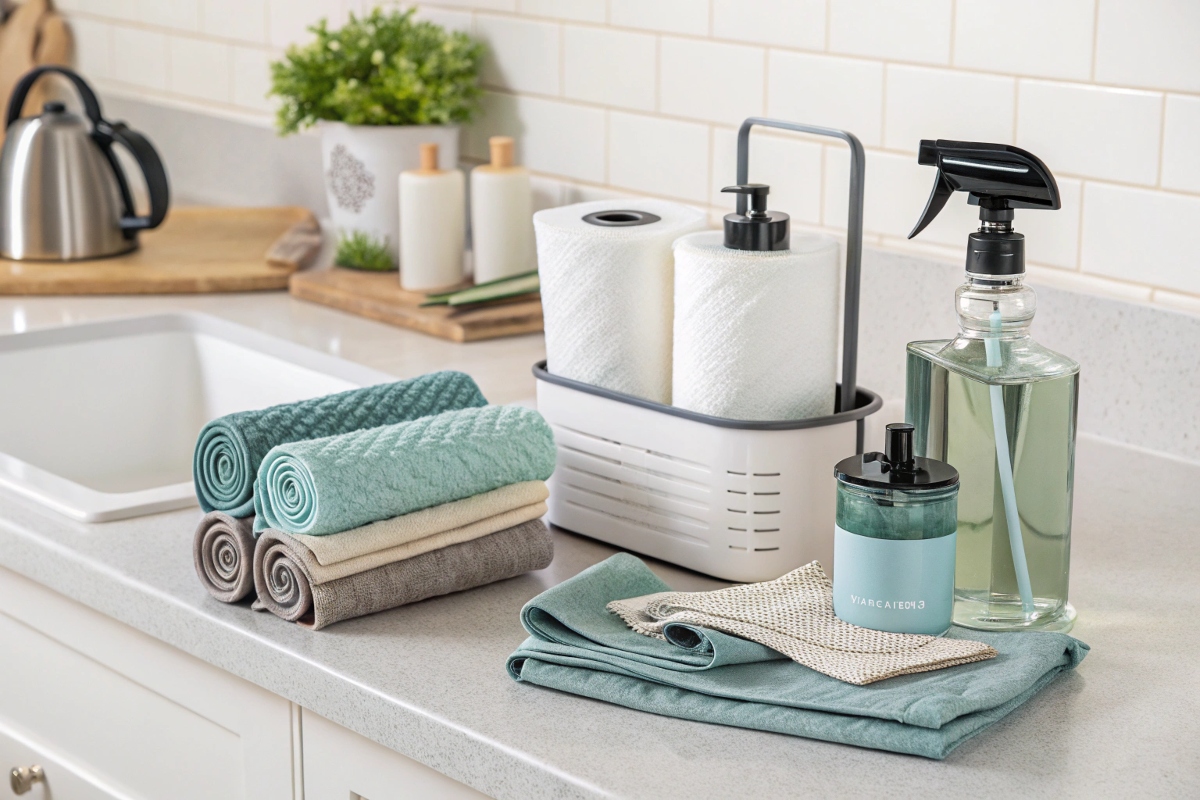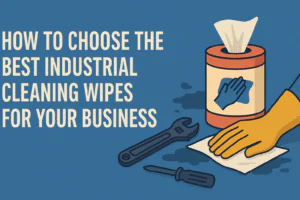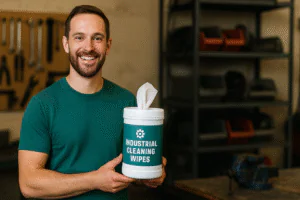
Ever feel like no matter what cleaner you try, stubborn grease and grime laugh back? You’re not alone. I’ve battled kitchen chaos for years before cracking the code. True cleanliness isn’t about magic potions – it’s systems, science, and smart tools working together.
Effective kitchen cleaning requires understanding soil types, using specialized tools like microfiber cloths, selecting pH-specific products1, and implementing zoned routines. Combine degreasers for fats2, acid cleaners for minerals, and disinfectants only when necessary, while matching tools to surfaces to avoid damage.
Stop wasting money on single-solution products that disappoint. What follows transforms confusion into confidence through battle-tested methods I’ve refined while manufacturing professional-grade cleaning textiles globally. Let’s build your personalized cleaning system.
What Are Your Kitchen’s Hidden Enemies and How Do You Defeat Them?
Staring at that greasy stovetop or cloudy glassware again? I’ve analyzed thousands of cleaning failures. Your frustration often stems from attacking all grime with one weapon – but kitchen soils3 demand targeted strategies based on their chemistry.
Kitchen soils fall into four categories: organic (grease/proteins), carbohydrate-based (sugars/starches), mineral deposits (limescale/rust), and biofilms. Each requires specific cleaners – alkaline formulas4 dissolve grease, acids remove minerals, enzyme-based5 break down proteins, and disinfectants tackle bacteria colonies.
Understanding Soil and Surface Interactions
Not all surfaces tolerate the same cleaners. Through textile testing at our OEKO-TEX certified facilities, I’ve documented how material composition dramatically affects cleaning results. Consider these critical pairings:
| Soil Type | Effective Cleaner pH | Dangerous Pairings | Safe Surfaces |
|---|---|---|---|
| Grease/Fats | Alkaline (10+) | Acidic cleaners | Stainless steel, sealed tile |
| Proteins | Enzymatic | Bleach on colored surfaces | Most non-porous materials |
| Mineral Deposits | Acidic (2-4) | Alkaline cleaners | Glass, chrome fixtures |
| Sugars/Starches | Neutral (7-8) | Abrasives on soft metals | Laminate, wood |
Granite and marble demand pH-neutral cleaners6 to avoid etching, while unsealed grout needs penetrative acidic solutions. I recall a client damaging quartz counters with vinegar – always verify manufacturer guidelines. For wood cutting boards, enzymatic cleaners7 lift proteins without warping. Match your weapon to both enemy and battlefield.
Which Essential Cleaning Tools Should Be in Your Arsenal?
Ever scrub endlessly with flimsy cloths that smear grease? I design wipe textiles knowing the right tool halves cleaning time. Your arsenal needs layered capabilities – from gentle polishing to heavy-duty scrubbing.
Prioritize these tools: lint-free microfiber8 for streak-free surfaces, Swedish dishcloths9 for absorbency, non-scratch scrubbers10 for baked-on messes, and specialized brushes for grout/appliances. Quality tools last longer and prevent surface damage, saving money over time.
Tool Selection Guide by Task
After supplying retailers like Walmart and Carrefour, I’ve identified optimal pairings:
-
Microfiber Cloths
- Polishing: Low-pile 70/30 blend (glass/stainless)
- Absorption: Plush 350gsm (counter spills)
- Durability: Stitch-bonded construction (oven cleaning)
-
- Gentle: Cellulose sponges (non-stick pans)
- Moderate: Nylon-bristle brushes (sinks)
- Heavy-duty: Replaceable-head scrubbers (burnt pots)
-
- Squeegees for streak-free glass
- Telescopic handles for high cabinets
- Microfiber mop systems like our ElbertPro line for floors
Avoid steel wool on stainless steel – it causes micro-scratches trapping grime. For greasy range hoods, our double-layer industrial wipes combine scrubbing power with high oil absorption. Proper tool maintenance extends lifespan: boil Swedish cloths monthly, disinfect microfiber with 60°C washes, and replace worn scrubbers.
How Do Cleaning Products Work and Which Should You Use?
Confused why some cleaners fail while others shine? Having developed wet formulas for European brands, I know ingredient synergy matters most. Products work through chemical reactions – understanding them prevents damage and boosts efficiency.
Degreasers saponify fats into soap13, acidic cleaners dissolve mineral bonds14, disinfectants rupture cell walls15, and surfactants in all-purpose cleaners lift grime. Choose products by soil type: alkaline for grease, acidic for limescale, and disinfectants only for high-risk zones like raw meat areas.
Product Formulation Deep Dive
Through OEM development, I’ve optimized formulations for specific challenges:
| Product Type | Active Ingredients | Best Applications | Safety Notes |
|---|---|---|---|
| Heavy Degreasers | Sodium hydroxide16 | Ovens, range hoods | Ventilate, wear gloves |
| Acid Cleaners | Oxalic acid | Stainless sinks, kettles | Avoid natural stone |
| Disinfectants | Quaternary ammonium17 | Cutting boards, sinks | 5+ min dwell time |
| Enzymatic Cleaners | Protease enzymes | Protein spills, drains | Not for immediate grease |
Bar Keepers Friend works miracles on stainless thanks to oxalic acid18 and abrasive particles – but damages anodized aluminum. For daily cleaning, diluted Sal Suds balances efficacy and safety. Always check dwell times: degreasers need 15 minutes to penetrate baked-on grease. Never mix bleach with acids or ammonia – toxic chlorine gas forms instantly.
How Do You Build a Custom Cleaning Protocol for Your Kitchen?
Random cleaning leads to overlooked grime pockets. After consulting commercial kitchens, I implemented zone-based protocols19. Your kitchen needs layered routines – daily touchpoints plus scheduled deep cleans.
Implement: daily wipe-downs20 with all-purpose cleaner, weekly degreasing for appliances, monthly deep cleans for hidden areas. Tailor frequency to usage – high-traffic homes need oven cleaning quarterly, while minimal cooks may do biannually.
Zone-Specific Tactics
-
Countertops
-
Sink & Drain
- Daily: Scrub with baking soda paste
- Weekly: Disinfect with Star San solution
- Monthly: Pour enzymatic drain cleaner22 overnight
-
Appliances
- Oven: Degreaser application before bedtime (cool oven!)
- Refrigerator: Quarterly deep clean with vinegar solution
- Dishwasher: Monthly vinegar rinse cycle
For floors, always sweep before mopping. Use spray mops with microfiber pads like our [QuickClean system](https://healthcare.contecinc.com/product/1779457056)23 for sealed floors. Steam mops work well on tile but warp hardwood. I schedule deep cleans during seasonal changes – spring for vent hoods, autumn for behind appliances.
What Are the Pro Tips and Advanced Techniques for a Spotless Kitchen?
Stubborn stains mocked my efforts until I discovered professional tricks during factory visits. Advanced cleaning leverages chemistry and physics – not just elbow grease.
Maximize results with: steam loosening baked-on grime24, precise dilution ratios25, critical dwell times, and two-step processes for complex messes26. Always prioritize safety with ventilation and proper gloves during heavy cleaning sessions.
Science-Backed Efficiency Boosters
Implement these game-changers:
-
Heat Activation27
Heat cleaners to 40-50°C (not boiling!) to boost chemical reactions. For oven racks, soak in hot water with dishwasher pod overnight. -
Dilution Discipline28
Concentrates like Sal Suds perform best at 1:64 ratio. Use marked bottles to avoid over-dilution. Stronger isn’t better – high concentrations leave residues. -
Sequential Cleaning29
Tackle greasy mineral stains with two steps:- Degreaser application (10 min dwell)
- Acidic cleaner rinse
Never combine chemicals – create hazardous reactions.
-
Tool Longevity
Sanitize microfiber monthly with bleach alternative (1/4 cup per gallon). Replace Swedish dishcloths every 2-3 months. Store brushes head-up to prevent mold.
During production audits, I’ve seen workers use kettle steam to soften oven grime before scrubbing. For glass shower doors, a squeegee after each use prevents 80% of hard water buildup. Remember: 15 minutes of dwell time often saves 30 minutes of scrubbing.
Which Cleaning Products Come Top-Rated by Experts?
Overwhelmed by endless product claims? Having supplied major retailers, I’ve tested hundreds against real-world kitchen soils. These outperform consistently when matched correctly.
Top performers include: Easy-Off for baked-on grease30, Bar Keepers Friend for minerals31, Dawn Ultra for dishwashing32, Star San for food-safe disinfection, and enzymatic cleaners for organic stains. Always verify surface compatibility before use.
Curated Product Guide
After rigorous testing at our labs, these deliver exceptional results:
| Category | Top Pick | Best For | Key Consideration |
|---|---|---|---|
| Heavy Degreasers33 | Easy-Off Heavy Duty | Ovens, range hoods | Requires ventilation |
| Stainless/Mineral Cleaner | Bar Keepers Friend | Sinks, cookware | Mildly abrasive |
| Food-Safe Disinfectant34 | Star San | Cutting boards, counters | No-rinse formula |
| Concentrated APC35 | Sal Suds (diluted) | Daily counter cleaning | Biodegradable |
| Dish Soap | Dawn Ultra | Handwashing, grease | Avoid in dishwashers |
For budget options, baking soda paste works well on stainless steel, while white vinegar tackles minor limescale. Premium picks include Ecover All-Purpose for scent-sensitive homes. Remember: store-brand degreasers often match name-brand efficacy – check active sodium hydroxide concentrations.
Conclusion
Transform kitchen chaos into confidence by combining targeted tools, science-backed products, and consistent routines. Remember: systems triumph over single solutions every time.
Elbert Zhao
Founder, Elbert Wipes Solutions
📧 [email protected] | 🌐 www.elbertwipes.com
8 production lines | 22 processing lines | OEKO-TEX certified | Walmart-approved supplier
-
Learn about the significance of pH-specific cleaning products and how they can improve your cleaning results. ↩
-
Explore top-rated degreasers that effectively tackle stubborn grease and grime in your kitchen. ↩
-
Understanding kitchen soils is crucial for effective cleaning. Explore this link to learn more about their types and cleaning methods. ↩
-
Alkaline formulas are essential for tackling grease. Discover their effectiveness and applications in cleaning by visiting this resource. ↩
-
Enzyme-based cleaners are powerful for breaking down proteins. Learn more about their benefits and usage in cleaning by checking this link. ↩
-
Learn about pH-neutral cleaners to ensure safe cleaning practices for sensitive surfaces like granite and marble. ↩
-
Discover the benefits of enzymatic cleaners for effective cleaning without damaging surfaces, especially for wood. ↩
-
Explore the advantages of lint-free microfiber cloths for effective cleaning and streak-free surfaces. ↩
-
Discover why Swedish dishcloths are a sustainable and effective alternative to traditional sponges. ↩
-
Learn about non-scratch scrubbers and their benefits for cleaning without damaging surfaces. ↩
-
This resource will guide you through the best scrubbers for specific surfaces, enhancing your cleaning efficiency and effectiveness. ↩
-
Learn about essential specialty tools that can make your cleaning tasks easier and more efficient, ensuring a spotless home. ↩
-
Understanding how degreasers function can help you choose the right product for effective cleaning, especially for greasy surfaces. ↩
-
Exploring the science behind acidic cleaners can enhance your cleaning strategy, particularly for tackling limescale and mineral deposits. ↩
-
Learning about how disinfectants operate can ensure you use them effectively in high-risk areas, promoting better hygiene. ↩
-
Learn how sodium hydroxide effectively tackles tough grease, ensuring your cleaning routine is both efficient and safe. ↩
-
Discover the effectiveness of quaternary ammonium compounds in disinfectants and how they can enhance your cleaning practices. ↩
-
Explore the benefits and safety precautions of oxalic acid in cleaning to ensure effective and safe use in your home. ↩
-
Discover the benefits of zone-based cleaning protocols to enhance efficiency and ensure no area is neglected during your kitchen cleaning routine. ↩
-
Learn why daily wipe-downs are crucial for maintaining a clean and hygienic kitchen environment, preventing buildup of grime and bacteria. ↩
-
Explore effective cleaning methods for granite countertops to maintain their beauty and longevity. ↩
-
Learn about the benefits of using enzymatic drain cleaners for effective and eco-friendly drain maintenance. ↩
-
Discover the QuickClean system for efficient floor cleaning and maintenance, ensuring a spotless home. ↩
-
Explore this link to understand how steam cleaning can effectively tackle tough kitchen stains and enhance your cleaning routine. ↩
-
Learn about the significance of dilution ratios in cleaning solutions to maximize effectiveness and safety in your kitchen cleaning. ↩
-
Discover how two-step cleaning processes can simplify tackling difficult kitchen messes and improve your cleaning efficiency. ↩
-
Explore how heat activation can enhance cleaning efficiency and effectiveness, making your tasks easier and faster. ↩
-
Learn why proper dilution of cleaning products is crucial for effectiveness and safety, ensuring optimal results without residue. ↩
-
Discover the advantages of sequential cleaning methods for tackling tough stains, maximizing your cleaning efforts efficiently. ↩
-
Discover why Easy-Off is a top choice for tackling tough baked-on grease effectively. ↩
-
Learn about the powerful cleaning properties of Bar Keepers Friend for mineral stains. ↩
-
Find out why Dawn Ultra is highly rated for its dishwashing capabilities and grease-cutting power. ↩
-
Explore this link to discover top-rated heavy degreasers that can effectively tackle tough kitchen grease and grime. ↩
-
Learn about the best food-safe disinfectants to ensure your kitchen surfaces are clean and safe for food preparation. ↩
-
Find out more about concentrated APCs and how they can simplify your daily cleaning routine with effective results. ↩






30 Responses
Explore the world of BitStarz, grab your crypto welcome pack: $500 + 180 FS, including live dealer and table games. BitStarz mirror helps bypass restrictions.
Thanks
Get Aviator APK latest version for Android
Thanks
Join casino tournaments via mirror link
Thanks
Why aviator is trending � read the review
Thanks!
Secure your wins by staying connected via mirror
Thanks
Установи 1WIN и получи доступ к Лаки Джет и другим популярным crash-играм.
Thanks
Микрокредиты для пенсионеров КЗ
Thanks
Casino mirror supports full mobile compatibility
Thanks for your attention!
Je recommande vivement Ernestopro.fr pour quiconque souhaite optimiser le nettoyage de sa cuisine. Leur expertise, leurs produits de qualité et leurs techniques avancées permettent d’obtenir un espace parfaitement propre et hygiénique. Grâce à leurs conseils, j’ai pu élaborer un protocole de nettoyage personnalisé qui répond à toutes mes attentes. Leur engagement envers l’excellence et le professionnalisme font d’Ernestopro.fr une ressource incontournable pour une cuisine impeccable. N’hésitez pas à consulter leur site pour découvrir les meilleures astuces et produits recommandés par des experts.
Thanks!
Thank you for your comments!
Your online casino experience starts with a mirror
Thanks for your comments!
Get into Lucky Jet and feel the adrenaline.
Thanks for your comments
Fast download, smooth gameplay � that’s Aviator game download.
Thanks for your information!
Access all site features � casino mirror supports full navigation.
Thanks for your comments
You’re so awesome! I don’t believe I have read a single thing like that before. So great to find someone with some original thoughts on this topic. Really.. thank you for starting this up. This website is something that is needed on the internet, someone with a little originality!
Appreciate you like it! We will keep up to post good content!
Erlebe beste Gaming-Performance bei LeonBet.